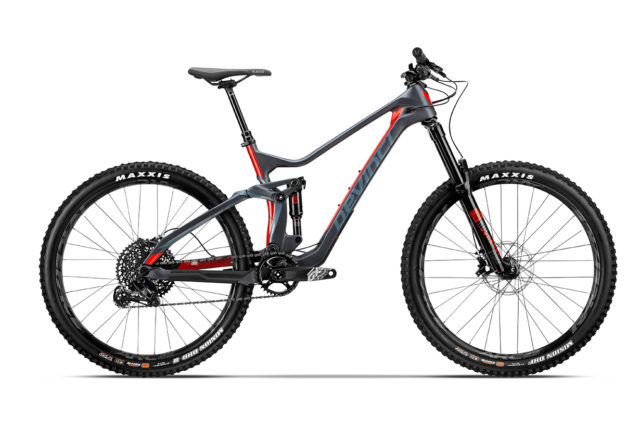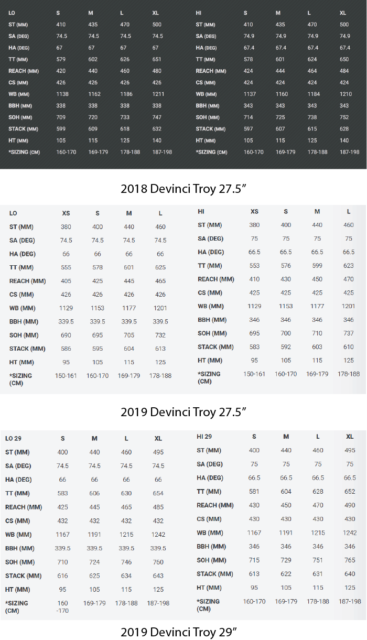For a couple years now, the Devinci Troy has been one of the bikes that I find myself recommending pretty often, and to a pretty wide spectrum of people. I know super fast rippers that are sending the Troy harder than most people will ever ride. I also know pretty low-key riders that just like churning out miles at an entirely moderate pace who are also big fans of the Troy. And I know some big guys that are hard on their equipment, and who like the Troy for being a bit overbuilt and carrying a good warranty. Any way you look at it, the Troy is just a great Trail bike that’s super capable without being so aggressive that “regular” riders can’t still appreciate it.
So Devinci has taken a good thing and messed around with it a bit. I haven’t swung a leg over the new Troy yet, but I have touched one in person, and my hopes / expectations are high that it’ll retain its position as one of my most recommended bikes.

Here are some assorted notes and thoughts that jump out at me when looking at the specs of the new Troy.
29” Wheels
First and foremost, the big news is that the Troy is now offered in both 29” and 27.5”-wheeled versions. This is good to see, since mid- to longer-travel 29ers make up a pretty competitive market segment right now, and there’s certainly room for another good option. But at the same time, the wagon wheels aren’t for everyone, so it’s good to see Devinci offering up options for everyone (except die-hard 26” wheel advocates of course, but yeah… those folks are gonna have to let that one die eventually).
140 mm / 150 mm travel
Travel on the new Troy remains the same as the old version — 140 mm in the back, 150 mm in the front. So the Troy is still positioned as a mid-travel Trail bike, or maybe an All-Mountain bike, depending on how you define those terms. However, the new Troy is now offered with a “limited” build kit that gets a 160 mm fork.
Geometry Changes
First, it’s worth noting that both the 27.5” and 29” wheeled versions of the Troy have pretty similar geometry numbers — similar head angles, reach measurements, and bottom bracket heights. The 29” version has longer chainstays and a longer wheelbase, which is to be expected with the bigger wheels. Because the head angles are the same between the 27.5” and 29” versions, I’d expect the 29”-wheeled version to feel like a bigger, burlier bike.

Like the old Troy, the new version still has a flip chip to switch the geometry between “Hi” and “Lo” modes, although that flip chip is now at the bottom shock mount. Compared to the old Troy, the new versions are about 1° slacker in each respective mode, reach numbers have grown a little bit (about 5 mm on a Medium), chainstay length remains the same (426 mm on the 27.5”-wheeled version), and the bottom bracket height isn’t changing dramatically.
Frame Changes
Yup, the Troy has gone Super Boost — a 157 mm spacing on the rear axle. So screw you and the nice boost-spaced wheelset you bought last year, thinking that it’d fit on your next bike.
Here are some other changes (or, in some cases, non-changes) to the frame of the Troy. Some for the good, some for the bad:
- The lines around the pivots have gotten cleaner. This is mostly an aesthetic thing, but they look good.
- Some of the pivots have gotten one-sided hardware (i.e. the pivot bolt doesn’t go all the way through). It looks clean, but it’s worse if something gets bunged up. Personally, I’m not a fan.
- The frame still has a threaded bottom bracket. That’s fantastic.
- Cable routing and ports are more refined and cleaner looking than the old version, and I think they’ll be good.
- Trunnion mount metric shock. Pretty much everything has gone metric, so that’s good. And I’m fine with the Trunnion mount.
- Rubber frame protectors are in the usual spots and seem to be well done.
- The bike fits a water bottle in the front triangle. I think it’ll even fit a large bottle. That’s awesome.
- The 27.5” version will fit up to 2.8” tires. But if you cram those in there, your bottom bracket is going to be pretty high.
- On the whole, the Troy’s frame still seems pleasantly overbuilt. The old Troy was a stiff, burly frame that could take some abuse. I think the new Troy will follow in those footsteps.
Aluminum
Like the old Troy, there will be both carbon- and aluminum-framed versions of the new Troy. That’s awesome, since plenty of people are willing to take a bit of a weight penalty to save some dinero.
Build Kits
You can wade through the pricing and build kits on Devinci’s website, but the one that jumps out at me is the “GX Eagle LTD” build. The fork bumps up to 160 mm travel (which is going to slacken the head angle around .5°) and it goes to a 42 mm offset. And that fork is a Rockshox Lyrik RC2, which is a really, really good piece of suspension. The LTD build saves a little money on the drivetrain with the entirely capable Sram GX Eagle kit, but goes high-end with the brakes (Sram Guide RSC) and also gets some upgraded wheels (Raceface Vault hubs and Arc35 rims). In other words, it has high-end suspension, brakes, and wheels, and saves a little money elsewhere. I think that sounds rad. At $5,799, it’s not exactly cheap, but that’s still a solid build for that price.

Superboost!
Another bike I don’t have to worry about even considering for purchase.